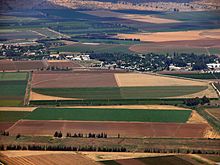Biodiversity in agriculture

Biodiversity in agriculture is the measure of biodiversity found on agricultural land.
Biodiversity is the measure of biotic and abiotic diversity in an ecosystem, described by heterogeneity.[1] The loss of biodiversity in agriculture has been an increasing issue since the global increase of food demands and success of popular crops.[3][4] This loss of heterogeneity declines species biodiversity on agricultural lands.[5] Biodiversity in agriculture is essential in providing ecosystem services, which conserves biodiversity while providing agricultural services.[6]
Biodiversity loss
Agriculture creates a conflict over the

The loss of habitat connectivity caused by
The Green Revolution
One of the issues facing biodiversity in areas of industrial agriculture is the loss of
Heterogeneity
Heterogeneity is essential in increasing species heterogeneity, which maintain stable ecological structures essential to providing ecosystem services.[5] Of the features associated with species diversity is land size, where a study proved a relationship between smaller agricultural fields and increased species richness.[15] The area of an agricultural field is associated with organisms accessibility to the edges of the field, which usually allow access for fields with different biophysical and geophysical features.[15] Increased accessibility to a diverse ecological features increases heterogeneity and reduces edge effects on populations inhabiting agricultural fields.[3][15]
Ecosystem services

Agriculture is a transformative process to any habitat, with a main focus on cultivating crops for human consumption.[16] Views on ecosystem services can be presented through viewpoints that benefit humans environmentally, economically, and culturally to motivate the practices that support ecosystem services in the agricultural industry.[16] For example, low crop diversity can increase pests and their resistance to pesticides, resulting in large ecological disturbances and economical losses.[6] This can be mitigated with increased crop rotation, which contributes to more diverse soil microbiota and insects that provide ecosystem services.[6] Another example is the conservation of pollinators such as honeybees that can contribute to the agricultural industry, where contributing to the increase of pollinators is reciprocated with increased crop production.[16]
See also
References
- ^ ISBN 978-0-521-76459-9.
- S2CID 256204561.
- ^ ISSN 0169-5347.
- ^ PMID 24591623.
- ^ S2CID 209571087.
- ^ PMID 26955069.
- ^ ISBN 978-1-4051-2249-8.
- ISBN 978-1-59726-269-9.
- ^ ISBN 978-1-59726-269-9.
- ^ a b "The future of agriculture depends on biodiversity". FAO Newsroom. Food and Agricultural Organization (FAO). 15 October 2004. Archived from the original on 17 January 2018. Retrieved 28 December 2018.
- ^ ISSN 1618-1476.
- ^ ISBN 978-1-4051-2249-8.
- S2CID 205458366.
- ^ PMID 22826253.
- ^ ISSN 0012-9658.
- ^ ISSN 0921-8009.
Further reading
- ISBN 978-0-444-50019-9.
- Dabbert S (2003). "Organic agriculture and sustainability: Environmental aspects". Organic Agriculture Sustainability, Markets and Policies: Sustainability, Markets and Policies. Paris, France: OECD Publications Service. ISBN 978-9-264-10151-7.
- Fiedler AK, Landis DA, Wratten SD (May 2008). "Maximizing ecosystem services from conservation biological control: the role of habitat management". Biological Control. 45 (2): 254–271. .
- Hole DG, Perkins AJ, Wilson JD, Alexander IH, Grice PV, Evans AD (March 2005). "Does organic farming benefit biodiversity?". Biological Conservation. 122 (1): 113–130. ISSN 0006-3207.
- Leopold A (1939). "The Farmer as a Conservationist". In Flader SL, Callicott JB (eds.). The River of the Mother of God. Madison WI: University of Wisconsin Press. pp. 255–265.
- Schmidt MH, Tscharntke T (January 2005). "The role of perennial habitats for Central European farmland spiders". Agriculture, Ecosystems & Environment. 105 (1–2): 235–242. .
- Shannon D, Sen AM, Johnson DB (September 2002). "A comparative study of the microbiology of soils managed under organic and conventional regimes". Soil Use and Management. 18: 274–283. S2CID 97962676.
- Zhang W, Ricketts TH, Kremen C, Carney K, Swinton SM (December 2007). "Ecosystem services and dis-services to agriculture". Ecological Economics. 64 (2): 253–260. .
